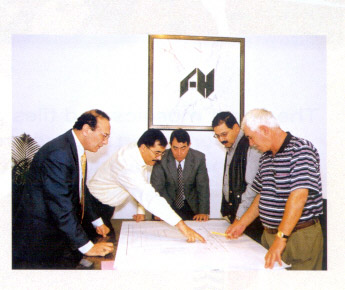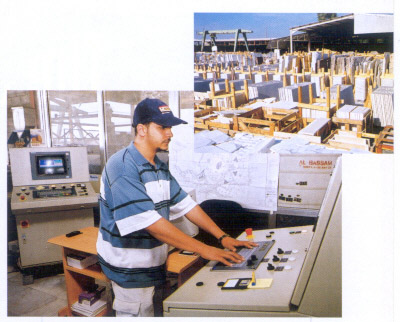|
Stone is a natural solid formation of one
or many minerals. There are thousands of
types of stones that have been quarried
through the centuries and quarries are
located all around the word. A majority of
natural stone comes from Italy, Spain,
Turkey, United States, Mexico, Portugal,
China, India, Greece, Canada, France and
Brazil.
The Earth developed as a massive body of
gas and liquid minerals that slowly cooled
and condensed to a solid core. Through
pressure, the Earth's crust began to form
and heavy minerals were forced down to the
core of the Earth, where they were
trapped. As the crust got thicker, it
squeezed around the inner core, which
created intense pressure and heat from
within the Earth. Crystals and other solid
forms began to grow from the mineral
vapors that were being released. As the
Earth's crust began to expand and erode,
heat and pressure pushed the solid
minerals up to the Earth's surface, which
formed colossal rock beds. It took up to
one hundred million years to form some of
these beds, many of which are now used as
quarries where the stone is mined.
One of the most prestigious companies in
the UAE market that deals with natural
stones is Al Habtoor Marble Company, which
is managed by Dr. Kasem Al Arouk. "
The familiar stone types today could be
identified in four categories:
Sedimentary, metamorphic, igneous stone
and man made" says Dr. Kasem. "
I want to give a short description for the
first three groups, as the nature of our
business is directly linked with them:
1.
Sedimentary stone came from organic
elements, such as glaciers, rivers, wind,
oceans and plants. Tiny sedimentary pieces
broke off from these elements and
accumulated to form rock beds. They were
bonded through millions of years of heat
and pressure. This category includes:
Limestone, Sandstone, Soapstone
Fossilstone and Travertine.
2.
Metamorphic stone originates from a
natural change from one type of stone to
another type through the mixture of heat,
pressure and minerals; the change may be a
development of a crystalline formation, a
texture change, or a colour change. This
category includes Marble, Slate and
Serpentine.
Marble is a beautiful and very popular
natural stone. It is actually a
recrystallyzed limestone that formed when
the limestone softened from heat and
pressure and recrystallyzed into marble
where mineral changes occurred. The main
consistency is calcium and dolomite. It
ranges in many colours and it is usually
heavily veined and shows lots of grains.
The veins and colour grains of marble were
actually liquid minerals that flowed
through the stone when the Earth heated
up; when the Earth cooled, the mineral
flow stopped and gradually hardened to its
current state. Marble is a relatively soft
stone, on a measurement of hardness scale
(MOHS), which is a guide developed in the
1800's and measures the stones resistance to hardness, marble is approximately
three-four out of ten. (The hardest stone
is the diamond, which measures the maximum
ten according to the MOHS). That's the
reason why marble as a decorative natural
stone is used mainly for interior
decoration.
3.
Igneous stones are mainly
formed through volcanic materials, such as
magma. Underneath the Earth's surface,
liquid magma cooled and solidified.
Mineral gases and liquids penetrated into
the stone and created new crystalline
formations with various colours. The most
famous volcanic stone is the Granite:
Primarily made of Quartz (35%), Feldspar
(45%) and Potassium it usually has darker
colours. It contains very little calcite
(if any at all) and provides a very
crystalline and granular appearance with
mineral grains. It is a very hard material
(approximately six according to MOHS) and
easier to maintain then the marble. This
is the main reason that the Granite is
mainly used as external decorative stone.

Profile
Al Habtoor Marble
Boom and bust come and go but Al Habtoor
Marble Co. has never ceased riding the
crest of the success wave. It is growth
and more growth for the company that has
outwitted many rivals in the market to
carve a big niche for itself in the UAE's
construction and property development
market.
"Our clients are free to use their
imagination and ideas that Al Habtoor
Marble transforms into a real masterpiece
of artwork and craftsmanship," says
Sami Al-Khairalla, Administration and
Finance Manager of the company.
This statement asserts the foremost role
of "imagination" that plays an
integral part in the business, in which Al
Habtoor Marble Company is in -where
natural stones and beauty are closely
bound with each other.
Sami says that the secret behind the
success of the Company is in its diligent
execution of projects in time without
compromising on quality even a wee bit.
That customer and his demands are
unquestionable priority focus.
No wonder since 1997 the company
has scored a consistent 300 per cent rise
in its turnover, a stupendous achievement
in such a short span of time.
Al Habtoor
Marble has played an integral role
in most of the strategic projects in the
UAE. To mention a few - the Burj Al Arab,
Dubai International Airport, Emirates
Towers, Dusit Dubai and other prestigious
projects.
Al Habtoor Marble which was established in
1975 at the Romool Industrial Area in
Dubai has come a long way and is now
charting out growth by foraying into
overseas markets. The company's growth has
been catalysed by Dubai's economic boom.
Construction, being one of the bedrock
industries of the emirate, grew at a brisk
pace and Al Habtoor Marble was one of the
major gainers. Among its partnerships, the
company remembers Al Habtoor Engineering,
which is on the growth trail. Al Habtoor
Engineering's success has helped Al
Habtoor Marble leverage sales growth in
Dubai by leaps and bounds.

The company has passed through various
stages of expansion in the last four years
and the rising fortunes of the UAE has
kept its business grow briskly.
"There was a big expansion in our
activities over the last four years as
business boomed," says
Mohammed Barakat, chief quantity surveyor
of the company. Business growth has
inevitably made the company take up more
premises. It has acquired a second premise
in Jebel Ali stretched over 200,000 square
feet. The company's present Rashidiya
premise is spread over 160,000 square
feet..
"Our growth has been driven by the
good cooperation of all our staff and
workers," says Barakat. The
management of the company cannot but pay
tribute to the sterling efforts of the
late general manager Firooz Roostazad.
"It is his special efforts that
kickstarted the company to the growth
phase," according to Barakat. Under the efficient management of Al Arouk now, the company
has been able to stick to the growth trail
unhindered by fluctuations in the market.
" There have been fluctuations in the
market, but we have been growing. The
strategy which drive our growth have both
short-term and long-term outlooks. We now
have proved that we are known to be the
best in the UAE market, though we are not
the only market player," says Sami.
A lion's share -about 90 per cent - of the
company's business is in the UAE but Al
Habtoor Marble is now a major and has the
might to venture in markets outside the
emirate. "We now have the ability to
challenge other major players outside the
UAE market, says Sami, outlining the
company's overseas strategy. Equally, in
its domestic business and overseas forays,
Al Habtoor Marble management does not
believe in jumping into projects. "We
go into the projects after careful
feasibility study and do not believe in
jumping into a project," says Sami.
The company's international exposure now
include the Sandy Lane Hotel in Barbados,
West Indies and Cadogan Place in London.
Al Habtoor Marble is also now busy weaving
a business strategy for the Kingdom of
Saudi Arabia. It participated in the
Kingdom Centre project in Saudi Arabia and
is currently in negotiations for more
projects with major contractors in the
Kingdom.
The company which bagged the ISO 9002
quality certification last year and is a
member of the American Institute of
Marble, is also eyeing the Qatar market as
part of the expansion. The future for Al
Habtoor Marble is promising with the
company gearing up to participate more
strongly in the marble market. "We
want to remain the best and sustain our
growth while serving the market in the UAE,"
say Sami. According to him, the company's
major asset is its people, most of whom
have stayed with Al Habtoor through the
thick and the thin. In fact there are
employees in the company who have been
with it for the last 25 years.
"Stability and accumulated experience
of our staff will translate into good
growth further,' says Barakat.
To adapt
with the changing times, Al Habtoor Marble
is currently looking at an integrated
software system, which will allow
customers to reach out to Al Habtoor
Marble through the worldwide web. A
complete e-commerce suite may not be the
ideal solution for the company since
physical feel and sight of
the marble, granite and precious
stones is a must in this business.
"The nature of our business is such
that customers need to come and approve
the product before delivery,' says Barakat.
The company mainly imports material on
demand from customers but it does have a
large stock ready always in its warehouse.
The source of imports is wide and varied
spanning Italy, Portugal, India, Spain,
Brazil and a number of other countries.
Al Habtoor Marble in the last four years
has etched its reputation in the UAE's
building materials market in marble. That
the market's ups and downs are not the
only factor which impacts growth for
companies and the essential quality
focus is an absolute must has been amply
proven by the company which is gearing up
to move into more greener pastures.
|
